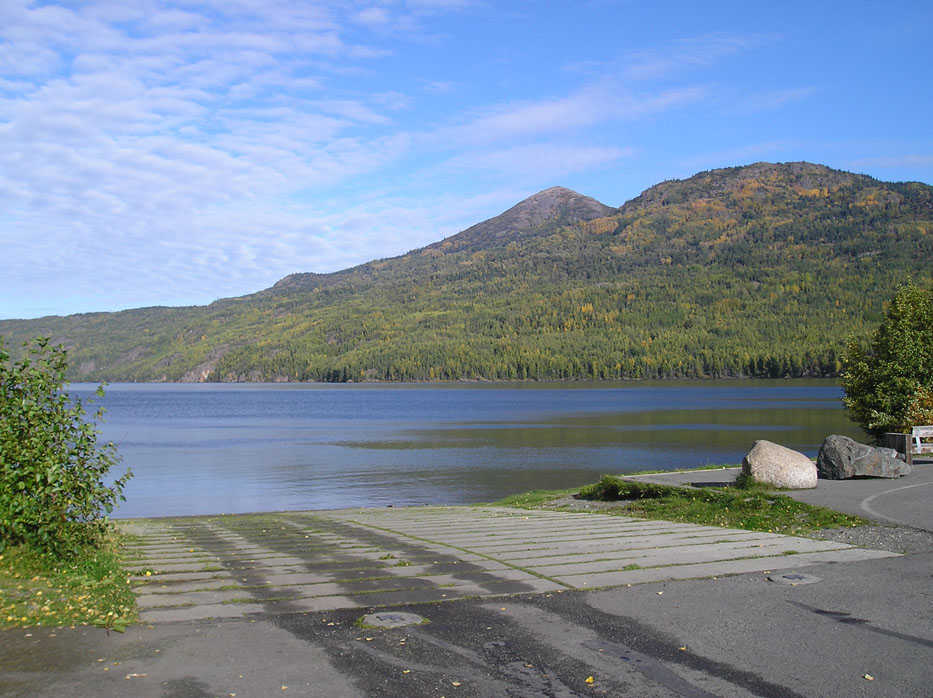I am often asked thought provoking questions while working in the Kenai Refuge Visitor Center. Recently, I was asked how Hidden Lake Campground received its name. It dawned on me that in the sixteen years I’ve worked here, I hadn’t given it much thought despite the huge amount of time I spend in the campground both for work and play. In writing this article, I did a little digging to uncover some interesting facts about this “hidden gem” of the Kenai Peninsula.
The 18.8 mile-long Skilak Lake Road was part of the original Sterling Highway built back in the late 1940s. Hidden Lake, largely unseen or “hidden” from this road, leads me to believe this may be the origin of its name.
Hidden Lake Campground, located 3.5 miles from the east entrance of Skilak Lake Road, is a favorite camping spot for locals and visitors where pleasures range from enjoying a campfire to sighting a black bear. Leaving technology behind helps you make an unhindered connection with nature to recharge your mind and spirit. The awe inspiring beauty of the area may also provoke your curiosity about the topography and forest history of this area.
Carved by glaciers amidst the 2,000 to 3,000 feet high Kenai Mountains, the Hidden Lake basin was deglaciated 14,000-16,000 years ago. Climbing on the exposed rocky outcrops within the campground, you can see the glacial striations — scratches in the rock caused by the tremendous weight and pressure of moving ice grinding and scarring the rocks.
From June-August 1947, a huge fire burned 300,000 acres of forest including areas around Hidden Lake. Sixty-seven years later, we see a mature boreal forest with primarily spruce and aspen trees. Within the campground, you can hike Burney’s Trail, named after a wildlife researcher who studied lynx and snowshoe hares in the early 90s in the Skilak area. This trail travels through spruce forest to a rocky outcrop viewpoint overlooking Hidden and Skilak Lakes. This is a good hike for bird lovers of all ages to look and listen for boreal and black-capped chickadees as well as Swainson’s and hermit thrushes.
Hidden Lake Campground received an overhaul in 1989 when the campground was paved, new camp loops were added (Ridge and Skyview) and sites were defined each with a parking space, hardened tent surface, fire grate, and picnic table. Now, as the largest Kenai Refuge campground with 44 camp sites, handicapped accessibility, picnic areas, and a boat launch, it receives the most camping use within the Refuge.
Throughout summer weekends, the boat trailer parking lot is full as visitors access the lake with canoes, kayaks, powerboats, and even a few sailboats. The depth of the lake varies from really shallow (less than 10 feet) to its maximum depth of 148 feet. The deepest portion of the lake is the first third of the lake from the boat launch to the start of the islands. According to Robert Begich with the Alaska Department of Fish and Game, “a feature that is attractive about Hidden Lake is that for a large lake it does not get too rough, and it is deep with relatively few boating hazards.” I know this for a fact as my family spends time fishing, exploring, boating and camping out along the islands.
A highlight of my summer is to catch a fresh “laker,” wrap it in aluminum foil, and cook it in a hot-coal campfire with butter and lemon and fry some potatoes on a skillet. Ken Gates at the Kenai Fish and Wildlife Field Office shares that “lake trout is likely the most popular fish people target in Hidden Lake followed by kokanee.” The lake supports the largest ice fishery on the peninsula. The lake also supports spawning and rearing sockeye, rearing coho salmon, rainbow trout and stickleback.
Hidden Lake Campground is just one of the “hidden gems” within the Kenai Refuge and would be an extraordinary place to experience during summer 2014. One way to experience this special place in depth is to become a campground host.
Kenai National Wildlife Refuge is currently recruiting campground hosts for Hidden Lake Campground for summer 2014 from mid-May to Labor Day. Camp Hosts have been present here since the early 1990s and are appreciated by campers for their friendly service. Their efforts to care for campgrounds and help visitors are tremendously important.
Hosts need their own trailer or camper and receive a tax free reimbursement stipend of $150 per person ($300 per couple) per week for groceries, personal supplies, propane, and generator gas. If you are interested or know of someone who would like to host, contact Education Specialist Michelle Ostrowski at 907-260-2839 or by email at michelle_ostrowski@fws.gov for more details.
Michelle Ostrowski is the Educational Specialist at the Kenai Refuge and has enjoyed working with “kids” of all ages since 1998. Find the Refuge on Facebook, or check out our current events at http://kenai.fws.gov/current.htm.

